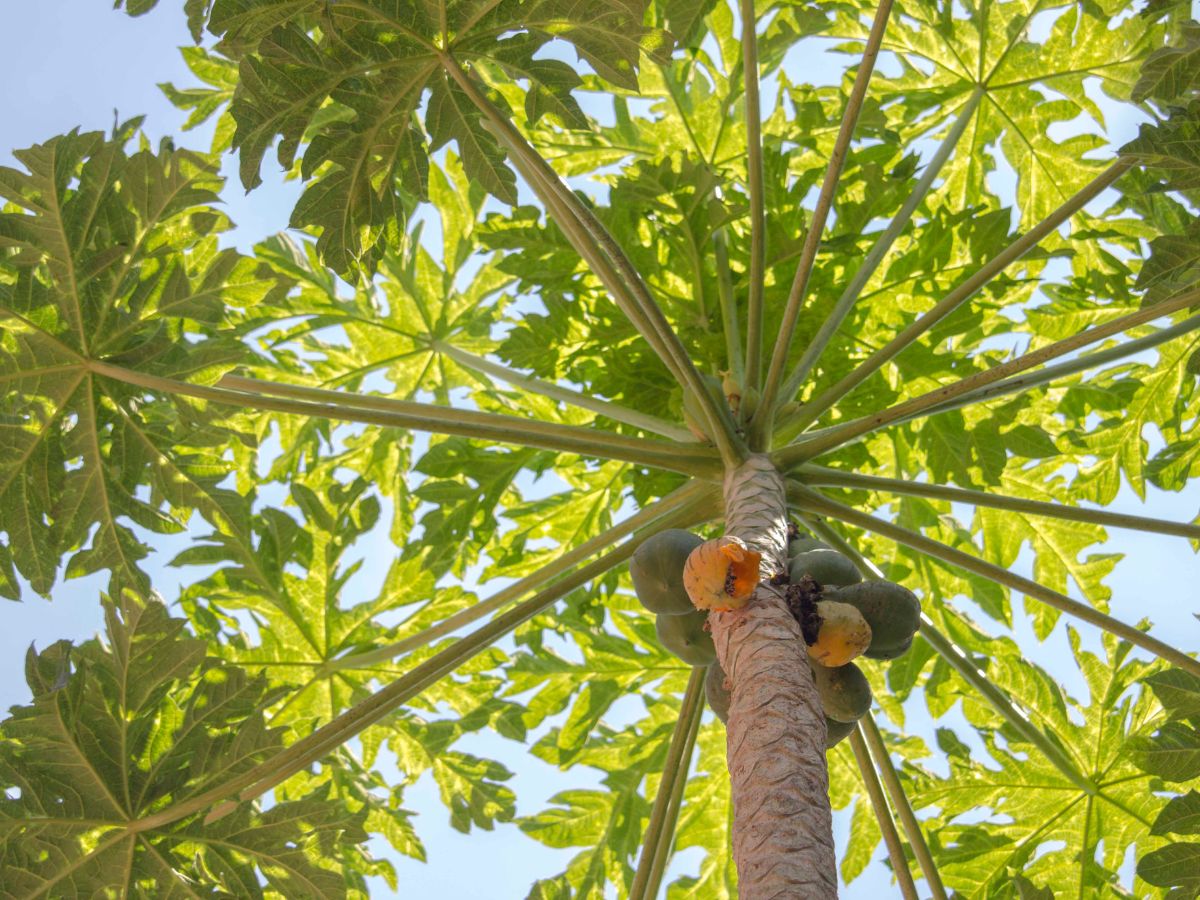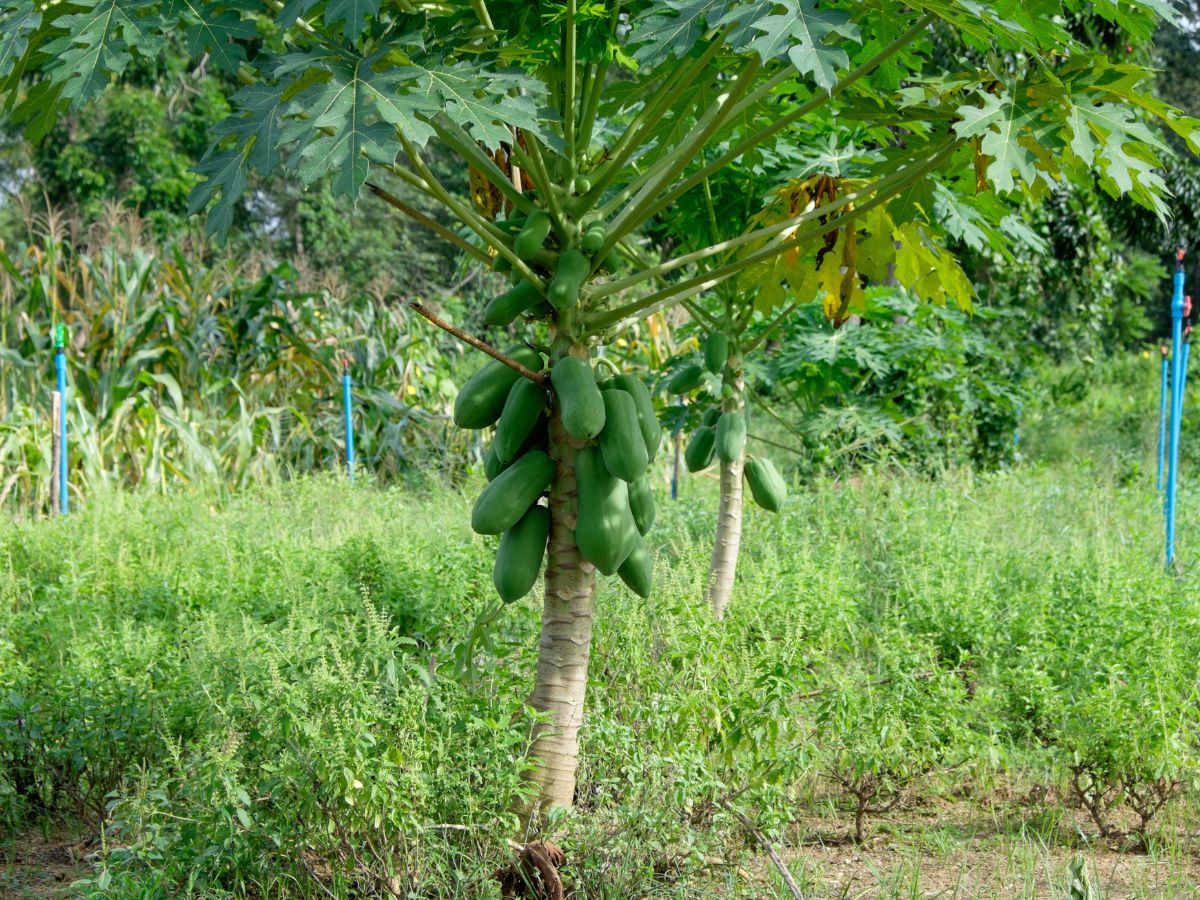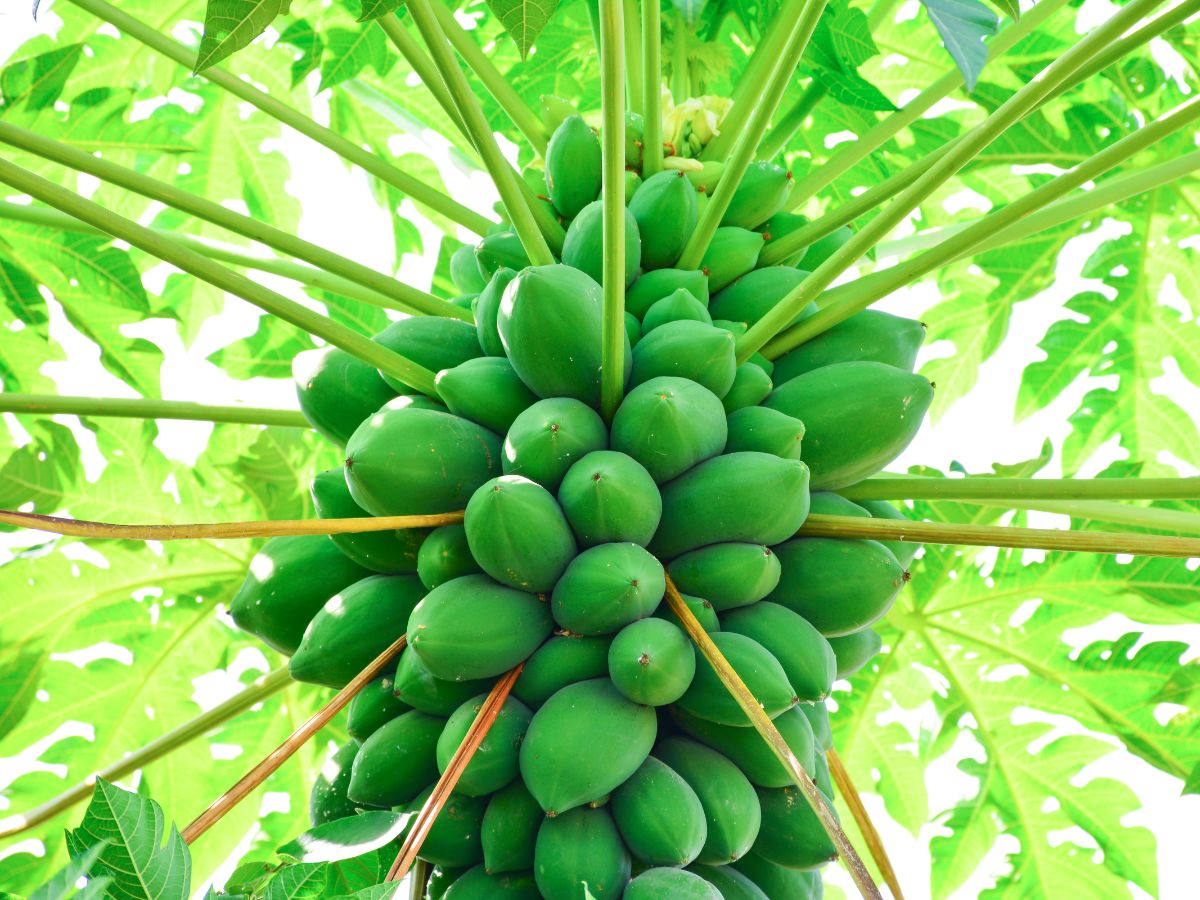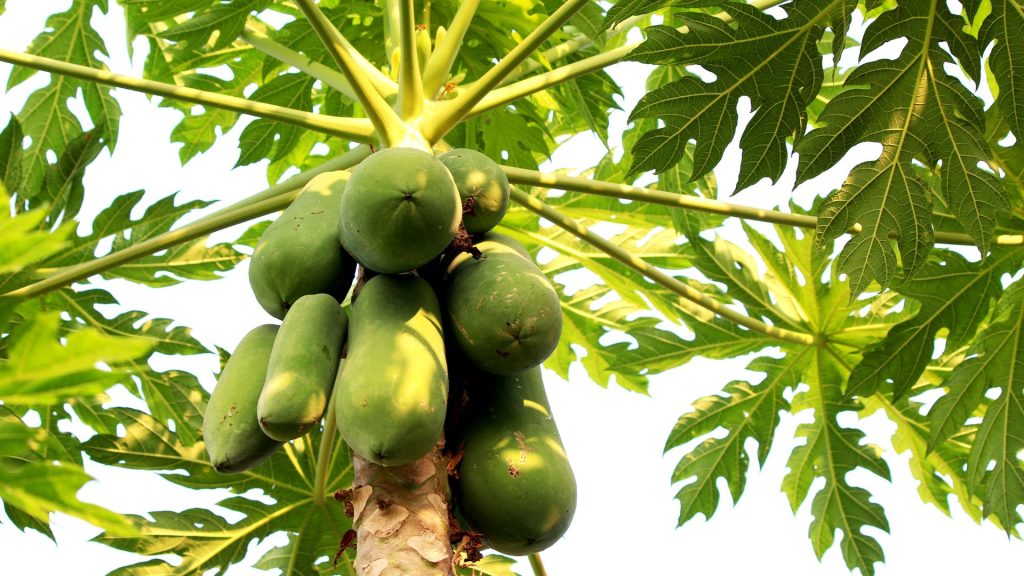Papaya (Carica papaya) is a perennial plant of Central American origin, fruits of which resemble a mixture of two flavors – strawberries and melons. The stem of papaya is very similar to bamboo, and the leaves are similar to maple but much larger. Papaya grows well not only outside but also at home or in a greenhouse in containers.
How Tall Do Papaya Trees Grow
Under natural conditions, the papaya tree size can reach 10-14 feet. Some growers recommend growing papaya in pots with low volume to limit its rapid growth. This technique gives its results – the papaya tree height would not exceed 6-7 ft, but the amount of harvest would also significantly decrease. You can also turn your attention to dwarf papaya trees such as Dwarf Solo Papaya Tree or The Red Lady Papaya which grow no taller than 5-6 feet in containers. These trees can bear fruit in 8-10 months.

Many believe that this plant lives for only 5 to 6 years when growing indoors. But this is not the case. If you take proper care of it and create the necessary favorable conditions, then it would be able to live up to 20 years and even more. When transplanting it for the summer period from a flower container to a garden plot, growth may increase at a rate familiar to natural conditions. Today we want to tell you what conditions the papaya tree needs and how to keep this beautiful plant short.
Location and Lighting
The location of the papaya flower pot should be in a warm or slightly cool room without cold drafts or sudden cold air currents. Although the plant prefers fresh air and regular ventilation, you need to be careful with this in winter so as not to harm a plant. A few minutes of such a cold stream is enough for all the leaves on the papaya to wither.
Temperature
Tropical papaya is now widespread in various parts of our planet and has managed to adapt to different temperature conditions and climates. But one of the important conditions and requirements is keeping it at a temperature that should exceed 32 °F. If only the air temperature drops to 30 °F, then it would be impossible to save the plant. Both the aboveground and root parts die off completely.
The ideal temperature for growing papaya at home or in the greenhouse is from 77 to 82 degrees Fahrenheit, but in no case more than 86 °F. High and low temperatures are equally dangerous for the plant. In winter, the optimal temperature range is 57-60 °F.
Watering
The root system of papaya is located close to the surface of the soil, so its top layer should not dry out between March and October. The roots need constant moderate humidity, without an excess of irrigation water. To avoid the appearance of root rot, it is recommended to reduce the volume and frequency of watering at low temperatures to a minimum. At this time, the root system is not working at full strength, and the usual amount of moisture can only harm the plant.
During the dormant period, papaya does not need watering since it has the ability of succulents to retain moisture and withstand drying out of the soil for some time. Dropping the leaves during the cool season is also a normal phenomenon for papaya and should not make the owner panic.
Topdressing and Fertilizers
Fast-growing tropical papayas during the spring and summer months would require a lot of strength and are nutritious in the form of fertilizers. Complex dry or liquid fertilizing (do not neglect also nutritious spraying of stems and leaves) is recommended to be applied to the soil regularly 2 times a month until the beginning of autumn. There is no need to feed the plant in the autumn-winter period.
Fruit Picking
For the papaya to begin to form fruits, it is necessary either to have a self-fertile variety or two plants at once – male and female, which can be pollinated under indoor conditions.
Fruit ripening occurs in late summer-early autumn. It is very important not to rush to harvest so that the papaya fruit ripens completely. Also, its milky juice, which is poisonous in green papaya, becomes watery and loses its dangerous properties.
How to Keep a Papaya Tree Short

When to Cut a Papaya?
The papaya should be shortened only after fruiting.
How to Cut Papaya Properly?
A single papaya trunk rarely branches in nature, and therefore its initial formation is minimal. Branching to limit stem height and facilitate harvesting can be caused by cutting off the top.
Trees that have grown too high or have outgrown the boundaries of the space allotted to them (such as in a greenhouse) you should short them to mid-height or cut off the trunk at a height of 2-3 ft from the ground. They usually respond well to this procedure, forming several young shoots from dormant buds at the bottom of the trunk. Form the most powerful shoot upright, trying to support it, and remove all other shoots at the base (they can be used as cuttings for vegetative propagation).
Use Only Sterile Instruments
Be sure to disinfect the tools before pruning, as this can cause various diseases. You can also use a variety of household cleaners such as isopropyl alcohol or bleach to thoroughly clean the blades before trimming.
Be Careful
Be sure to wear protective goggles and gloves when trimming. The thing is that papaya juice can cause skin irritation, severe allergic reactions, or difficulty breathing.
How to Cut Papaya Fruit

Here are the three easiest and most common ways:
- Cut the fruit in half, remove the peel and pits, cut across or into cubes.
- Cut lengthwise into slices like a watermelon.
- Cut in half, remove seeds and scoop out the pulp with a spoon.
The benefits of papaya are beyond question. This tropical fruit is rich in sugars, organic acids, fiber, and protein. Together with sweet pulp, beta-carotene, B vitamins, vitamin C, vitamin D, folic acid enter the body. Of the mineral elements in papaya, calcium, sodium, potassium, phosphorus, iron, and others are present.
Frequently Asked Questions (FAQs)
What is a papaya tree?
A papaya tree is a tropical fruit tree belonging to the Caricaceae family, scientifically known as Carica papaya. It is native to Mexico and Central America but is now widely cultivated in tropical and subtropical regions around the world.
What are the different varieties of papaya trees?
There are several varieties of papaya trees, including the Hawaiian papaya (Solo or Sunrise varieties), Mexican papaya (Maradol variety), and the wild papaya (Vasconcellea pubescens). The Hawaiian papaya is smaller in size, while the Mexican papaya is larger and has a sweeter taste.

What are the requirements for growing papaya trees?
Papaya trees require warm temperatures, well-drained soil, and plenty of sunlight. They prefer a tropical or subtropical climate and are sensitive to frost. They also need regular watering and proper fertilization to thrive.
How long does it take for a papaya tree to bear fruit?
Papaya trees typically start bearing fruit within 6 to 9 months from planting, although it can take up to a year or more depending on growing conditions and variety. They usually have a lifespan of 3 to 5 years, after which their fruit production declines.
Can papaya trees be grown in containers?
Yes, papaya trees can be grown in containers, but they require adequate space for root growth and should be placed in a location with sufficient sunlight. Choose a large container with drainage holes and use well-draining soil. Regular watering and fertilization are important for container-grown papaya trees. However, they may not grow as large or produce as much fruit as those grown in the ground.
Are papaya trees susceptible to pests and diseases?
Yes, papaya trees can be susceptible to pests such as aphids, mealybugs, and fruit flies, as well as diseases such as papaya ringspot virus, powdery mildew, and black spot. Proper care and maintenance, including regular monitoring, pruning, and use of organic or chemical controls when necessary, can help prevent or manage pests and diseases in papaya trees.
Are papaya trees dioecious or monoecious?
Papaya trees can be either dioecious or monoecious. Dioecious trees have male and female flowers on separate plants, while monoecious trees have both male and female flowers on the same plant. Most papaya trees are actually monoecious, meaning they have separate male and female flowers on the same tree. However, some papaya trees can be dioecious, with separate male and female trees. It’s important to have both male and female trees in the vicinity for proper pollination and fruit set, especially for dioecious varieties.
Are papaya fruits ripe when they are green?
No, papaya fruits are not typically ripe when they are green. Most papayas are harvested and consumed when they are fully ripe, which is indicated by a change in skin color from green to yellow, orange, or red (depending on the variety). Ripe papayas are also slightly soft to the touch and have a sweet aroma. However, some papaya varieties, such as the Mexican Maradol, are known to be consumed while still green and slightly firm, with a savory taste and firmer texture compared to fully ripe papayas.
Can I eat papaya leaves or use them for medicinal purposes?
Papaya leaves are not commonly consumed as food, but they have been used for medicinal purposes in some cultures. Papaya leaves are believed to have various health benefits and are often used as a natural remedy for digestive issues, dengue fever, and other ailments. However, it’s important to note that the use of papaya leaves for medicinal purposes should be done under the guidance of a qualified healthcare professional, as they may have potential side effects or interactions with medications.
Conclusion
To provide a daily intake of various vitamins, it would be enough to eat 300-400 g of papaya pulp. This delicacy would also be a wonderful decoration for any garden or greenhouse. So if your climatic conditions are right for this beautiful tree, consider this edible decoration.


